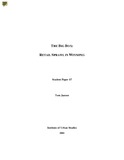| dc.contributor.author | Janzen, Tom | |
| dc.date | 2002 | |
| dc.date.accessioned | 2011-06-01T20:39:31Z | |
| dc.date.available | 2011-06-01T20:39:31Z | |
| dc.identifier.isbn | 1-894858-03-4 | |
| dc.identifier.uri | http://hdl.handle.net/10680/333 | |
| dc.description | Online resource: ii, 20 pp.; ill., digital file. | |
| dc.description.abstract | Pioneered by massive retail chains like Wal-Mart and Home Depot, retail development in North America over the last decade has seen an increasing trend toward suburban “big-box” stores. Like most North American cities and towns, Winnipeg has experienced this trend first hand. Although its proponents often tout this type of development as a source and sign of economic development, a more careful examination of the physical and economic effects of big-box development reveals that it comes at considerable cost; requiring expensive infrastructure, increasing automobile dependency, and decimating local and downtown retail markets. As a result, the big-box trend is being met by an increasing resistance by many local and even national governments worldwide. The purpose of this report is to examine what Winnipeg has done to encourage and/or discourage suburban big-box development, and, drawing on what other communities have done or are doing, propose ways that Winnipeg can limit or at least control big-box development more effectively in the future. | en_US |
| dc.language.iso | en | en_US |
| dc.publisher | Institute of Urban Studies | |
| dc.relation.ispartofseries | Student Paper Series;17 | |
| dc.rights | info:eu-repo/semantics/openAccess | |
| dc.subject | Urban Planning | en_US |
| dc.subject | Land Use Planning | en_US |
| dc.subject | Retail Development | en_US |
| dc.subject | Suburban Planning | en_US |
| dc.subject | Suburban Cities and Towns | en_US |
| dc.title | The Big Box: Retail Sprawl In Winnipeg | en_US |
| dc.type | Article | en_US |

